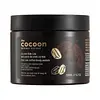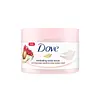What's inside
What's inside
 Key Ingredients
Key Ingredients

 Benefits
Benefits

 Concerns
Concerns

 Ingredients Side-by-side
Ingredients Side-by-side

Water
Skin ConditioningCoffea Robusta Seed Powder
AbrasiveCetearyl Alcohol
EmollientCocos Nucifera Oil
MaskingCocamidopropyl Betaine
CleansingGlyceryl Stearate
EmollientC15-19 Alkane
SolventGlycerin
HumectantCeteareth-20
CleansingCeteareth-12
EmulsifyingTheobroma Cacao Seed Butter
EmollientButyrospermum Parkii Butter
Skin ConditioningCetyl Palmitate
EmollientGlycine Soja Sterols
EmollientPhospholipids
Skin ConditioningGlycolipids
Skin ConditioningHydroxypropyl Starch Phosphate
Glycine Soja Oil
EmollientParfum
MaskingAcrylates/C10-30 Alkyl Acrylate Crosspolymer
Emulsion StabilisingTocopheryl Acetate
AntioxidantXanthan Gum
EmulsifyingPhenoxyethanol
PreservativeSodium Hydroxide
BufferingBHT
AntioxidantEthylhexylglycerin
Skin ConditioningTrisodium Ethylenediamine Disuccinate
Water, Coffea Robusta Seed Powder, Cetearyl Alcohol, Cocos Nucifera Oil, Cocamidopropyl Betaine, Glyceryl Stearate, C15-19 Alkane, Glycerin, Ceteareth-20, Ceteareth-12, Theobroma Cacao Seed Butter, Butyrospermum Parkii Butter, Cetyl Palmitate, Glycine Soja Sterols, Phospholipids, Glycolipids, Hydroxypropyl Starch Phosphate, Glycine Soja Oil, Parfum, Acrylates/C10-30 Alkyl Acrylate Crosspolymer, Tocopheryl Acetate, Xanthan Gum, Phenoxyethanol, Sodium Hydroxide, BHT, Ethylhexylglycerin, Trisodium Ethylenediamine Disuccinate
Water
Skin ConditioningGlycerin
HumectantHydrated Silica
AbrasiveSodium Lauroyl Isethionate
CleansingStearic Acid
CleansingSodium Stearate
CleansingCocamidopropyl Betaine
CleansingParfum
MaskingSodium Palmitate
CleansingCetearyl Alcohol
EmollientLauric Acid
CleansingSodium Isethionate
CleansingJojoba Esters
EmollientPhenoxyethanol
PreservativeHydroxyacetophenone
AntioxidantSodium Chloride
MaskingSodium Palm Kernelate
CleansingTetrasodium EDTA
Sodium Benzoate
MaskingZinc Oxide
Cosmetic ColorantPunica Granatum Seed Powder
AbrasiveButyrospermum Parkii Butter
Skin ConditioningSodium Hydroxide
BufferingBenzyl Salicylate
PerfumingHexyl Cinnamal
PerfumingLinalool
PerfumingCI 77491
Cosmetic ColorantCI 77891
Cosmetic ColorantCI 17200
Cosmetic ColorantWater, Glycerin, Hydrated Silica, Sodium Lauroyl Isethionate, Stearic Acid, Sodium Stearate, Cocamidopropyl Betaine, Parfum, Sodium Palmitate, Cetearyl Alcohol, Lauric Acid, Sodium Isethionate, Jojoba Esters, Phenoxyethanol, Hydroxyacetophenone, Sodium Chloride, Sodium Palm Kernelate, Tetrasodium EDTA, Sodium Benzoate, Zinc Oxide, Punica Granatum Seed Powder, Butyrospermum Parkii Butter, Sodium Hydroxide, Benzyl Salicylate, Hexyl Cinnamal, Linalool, CI 77491, CI 77891, CI 17200
 Reviews
Reviews

Ingredients Explained
These ingredients are found in both products.
Ingredients higher up in an ingredient list are typically present in a larger amount.
This ingredient is also known as shea butter. It is an effective skin hydrator and emollient.
Emollients help soothe and soften your skin. It does this by creating a protective film on your skin. This barrier helps trap moisture and keeps your skin hydrated. Emollients may be effective at treating dry or itchy skin.
Shea butter is rich in antioxidants. Antioxidants help fight free-radicals, or molecules that may harm the body. It is also full of fatty acids including stearic acid and linoleic acid. These acids help replenish the skin and keep skin moisturized.
While Shea Butter has an SPF rating of about 3-4, it is not a sunscreen replacement.
Shea butter may not be fungal acne safe. We recommend speaking with a professional if you have any concerns.
Learn more about Butyrospermum Parkii ButterCetearyl alcohol is a mixture of two fatty alcohols: cetyl alcohol and stearyl alcohol. It is mainly used as an emulsifier. Emulsifiers help prevent the separation of oils and products. Due to its composition, it can also be used to thicken a product or help create foam.
Cetearyl alcohol is an emollient. Emollients help soothe and hydrate the skin by trapping moisture.
Studies show Cetearyl alcohol is non-toxic and non-irritating. The FDA allows products labeled "alcohol-free" to have fatty alcohols.
This ingredient is usually derived from plant oils such as palm, vegetable, or coconut oils. There is debate on whether this ingredient will cause acne.
Due to the fatty acid base, this ingredient may not be Malassezia folliculitis safe.
Learn more about Cetearyl AlcoholCocamidopropyl Betaine is a fatty acid created by mixing similar compounds in coconut oil and dimethylaminopropylamine, a compound with two amino groups.
This ingredient is a surfactant and cleanser. It helps gather the dirt, pollutants, and other impurities in your skin to be washed away. It also helps thicken a product and make the texture more creamy.
Being created from coconut oil means Cocamidopropyl Betaine is hydrating for the skin.
While Cocamidopropyl Betaine was believed to be an allergen, a study from 2012 disproved this. It found two compounds in unpure Cocamidopropyl Betaine to be the irritants: aminoamide and 3-dimethylaminopropylamine. High-grade and pure Cocamidopropyl Betaine did not induce allergic reactions during this study.
Learn more about Cocamidopropyl BetaineGlycerin is already naturally found in your skin. It helps moisturize and protect your skin.
A study from 2016 found glycerin to be more effective as a humectant than AHAs and hyaluronic acid.
As a humectant, it helps the skin stay hydrated by pulling moisture to your skin. The low molecular weight of glycerin allows it to pull moisture into the deeper layers of your skin.
Hydrated skin improves your skin barrier; Your skin barrier helps protect against irritants and bacteria.
Glycerin has also been found to have antimicrobial and antiviral properties. Due to these properties, glycerin is often used in wound and burn treatments.
In cosmetics, glycerin is usually derived from plants such as soybean or palm. However, it can also be sourced from animals, such as tallow or animal fat.
This ingredient is organic, colorless, odorless, and non-toxic.
Glycerin is the name for this ingredient in American English. British English uses Glycerol/Glycerine.
Learn more about GlycerinParfum is a catch-all term for an ingredient or more that is used to give a scent to products.
Also called "fragrance", this ingredient can be a blend of hundreds of chemicals or plant oils. This means every product with "fragrance" or "parfum" in the ingredients list is a different mixture.
For instance, Habanolide is a proprietary trade name for a specific aroma chemical. When used as a fragrance ingredient in cosmetics, most aroma chemicals fall under the broad labeling category of “FRAGRANCE” or “PARFUM” according to EU and US regulations.
The term 'parfum' or 'fragrance' is not regulated in many countries. In many cases, it is up to the brand to define this term.
For instance, many brands choose to label themselves as "fragrance-free" because they are not using synthetic fragrances. However, their products may still contain ingredients such as essential oils that are considered a fragrance by INCI standards.
One example is Calendula flower extract. Calendula is an essential oil that still imparts a scent or 'fragrance'.
Depending on the blend, the ingredients in the mixture can cause allergies and sensitivities on the skin. Some ingredients that are known EU allergens include linalool and citronellol.
Parfum can also be used to mask or cover an unpleasant scent.
The bottom line is: not all fragrances/parfum/ingredients are created equally. If you are worried about fragrances, we recommend taking a closer look at an ingredient. And of course, we always recommend speaking with a professional.
Learn more about ParfumPhenoxyethanol is a preservative that has germicide, antimicrobial, and aromatic properties. Studies show that phenoxyethanol can prevent microbial growth. By itself, it has a scent that is similar to that of a rose.
It's often used in formulations along with Caprylyl Glycol to preserve the shelf life of products.
Sodium Hydroxide is also known as lye or caustic soda. It is used to adjust the pH of products; many ingredients require a specific pH to be effective.
In small amounts, sodium hydroxide is considered safe to use. However, large amounts may cause chemical burns due to its high alkaline.
Your skin has a natural pH and acid mantle. This acid mantle helps prevent harmful bacteria from breaking through. The acid mantle also helps keep your skin hydrated.
"Alkaline" refers to a high pH level. A low pH level would be considered acidic.
Learn more about Sodium HydroxideWater. It's the most common cosmetic ingredient of all. You'll usually see it at the top of ingredient lists, meaning that it makes up the largest part of the product.
So why is it so popular? Water most often acts as a solvent - this means that it helps dissolve other ingredients into the formulation.
You'll also recognize water as that liquid we all need to stay alive. If you see this, drink a glass of water. Stay hydrated!
Learn more about Water